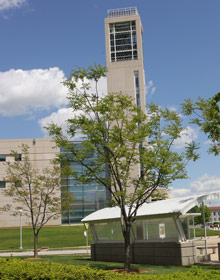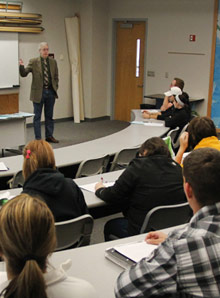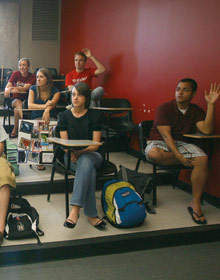
In this issue of Clif’s Notes, I want to update you on the budget for fiscal year 2013 and share with you the new Academic Administrators Return to Faculty Policy.
 Fiscal year 2013 budget
Fiscal year 2013 budget
I am sure you heard about Governor Nixon amending his budget recommendation for fiscal year 2013 by adding $40 million back into the overall higher education budget. The funding is part of a lawsuit settlement from which Missouri benefits.
That means the overall reduction for higher education is now proposed to be $66 million (7.78 percent) rather than the original $106 million (12.5 percent). For Missouri State, that means the reduction is $5,988,547 rather than $9,620,332, a difference of $3,631,785.
Based on this new information, we are adjusting our initial plans:
- First, and most importantly, with a 7.78 percent reduction in state appropriations, we believe we can keep the increase in tuition and fees for undergraduate resident students to 3.1 percent or less, which will not require Missouri State to request a waiver.
- Second, in an attempt to further protect the quality of our academic programs, we are reducing the amount colleges have to reallocate for fiscal year 2013 by $490,869.
- And third, since we are reducing the reallocation target for colleges, we are encouraging colleges to consider using as few one-time funds as possible to cover the reallocation.
Here, in admittedly simplified terms, is the summary I shared with the Executive Budget Committee at its Feb. 10 meeting:
Decreased appropriations and cost increases
| Decrease of 7.78% in state appropriations (at 12.5% was $9,620,332.90, difference of $3,631,785.73) |
$ 5,988,547.17 |
| Faculty promotions | 231,000.00 |
| Mid-year raise with 32.5% fringe benefits | 1,923,292.22 |
| Increase in benefits from 32.5% to 33.8% | 1,110,046.03 |
| Employee and student fee waiver increase | 1,042,608.65 |
| Bad debt increase | 600,000.00 |
| Other expense increases | 843,592.98 |
| Total | $11,739,087.05 |
Increases in revenue and expense reduction
| Tuition increase (was $6,047,377.94 with 6.2% in resident undergraduate increase, difference of $1,923,869.04) | $ 4,123,508.90 |
| College of Business Administration fee (80% of total) | 1,120,000.00 |
| Cost center reductions (salary and benefits identified above) | 3,033,338.25 |
| Additional non-academic/provost cost center reductions (was $700,000, difference of $490,869.32) |
209,130.68 |
| Reduction in President’s Enhancement Fund | 2,000,000.00 |
| Additional transfer from auxiliaries | 750,000.00 |
| Facilities and administration revenue from indirect costs generated by grants and sponsored programs — vice president’s percentage only | 400,000.00 |
| West Plains contribution | 100,000.00 |
| Reduced maintenance and repair and classroom upgrades (was $1,225,000) |
0.00 |
| Total | $11,735,977.83 |
You can tell there are many details yet to be worked out, but this provides a summary that I hope is helpful.
I have presented this plan to the Executive Budget Committee and the Administrative Council, and both groups gave unanimous approval for it. I plan to brief the Board of Governors on it at the Feb. 17 meeting. I believe we are now to a point where the various budget committees, working with the cost center administrators, should finalize their specific reallocation plans. Those plans will be reviewed by the chief financial officer and moved up the academic budget process. The goal is to have a firm plan in the next 45 to 60 days.
 Special kudos to our student leaders
Special kudos to our student leaders
I want to give special recognition to our student leaders. On Feb. 7, the Student Government Association had a first reading of a resolution that supported the University and indicated the students’ willingness to support an increase in tuition and fees on undergraduate resident students of up to 6.5 percent to help cover the proposed 12.5 percent reduction in state appropriations. In short, the students chose quality over absolute price. I am providing a link to that resolution here. I thought you would want to be aware of this.
Reminders about the budget
Finally, let me provide four reminders.
-

First, there have not been any changes to the budget decisions I shared in the last Clif’s Notes. Please review those.
- Second, remember that our budget model is predicated on recouping the 146 students we lost in the fall of 2011. And, if we are able to increase enrollment, that helps the budget even more. So, enrollment and retention remain a high priority.
- Third, while it is great news that the reduction has been decreased from 12.5 percent to 7.78 percent, the $5.99 million reduction in state funding is real money and I don’t want to minimize the challenge we will have in filling that hole.
- And fourth, please note that the $40 million added to the higher education budget is one-time money, which means we will have to revisit that issue next year. The hope is that the state’s economy will continue to improve so that the hole is filled with on-going funding. For now, the one-time $40 million helps bridge the gap for fiscal year 2013.
The legislative session continues through May 18 and I will keep you informed of other developments as the budget moves through the process. Thanks for your patience and understanding as we adjust to new information.
Academic Administrators Return to Faculty Policy
Committee reports
One of the first things I did as interim president was to ask Drs. Einhellig and Gallaway to appoint an ad-hoc committee to review and improve the Academic Administrators Return to Faculty Policy. That committee was led by Dr. Sue George and included members Drs. Richard Biagioni, Janice Greene, Terrel Gallaway, Tom Kane, and Kent Ragan. The committee completed its report in late November.
Related, the Faculty Senate Ad-Hoc Committee on Heads/Chairs completed its report in December.
 New policy
New policy
On Friday (Feb. 17), I will report to the Board of Governors that we will soon have a new administrative policy on Academic Administrators Return to Faculty. This policy adopts a significant number of the specific recommendations made in these reports, especially related to administrators returning to faculty.
The issue of administrators returning to faculty remains an important, sensitive topic. One of my first pledges to you was that we would address it. The key was to balance the University’s goal of attracting and retaining outstanding administrators with paying returning administrators appropriately upon their return to the faculty. Thanks to the ad-hoc committee reports and the insights of many, both faculty and administrators, I believe we have found that balance. I invite you to review the new policy and judge for yourself.
We will implement the policy beginning with appointment letters beginning in the fall 2012 and we will monitor it closely to ensure it is achieving the multiple goals we have for it. All of us should reserve the right to revisit the policy if we find adjustments need to be made. I anticipate that many of the principles adopted here will also be incorporated into the contract for the next University president.
I want to thank all of you who contributed to this policy. It is a better policy because of your involvement.
Conclusion
Please be assured that I appreciate all you do and I will continue to keep you informed.
 –Clif
–Clif

M issouri State undergraduate physics students assisted approximately 85 second and third graders Jan. 28 as the College of Natural and Applied Sciences hosted the Girl Scout Brownie Science Day. The students led demonstrations and assisted the Brownies as they completed science experiments, which earned them the new “Home Scientist” badge.
issouri State undergraduate physics students assisted approximately 85 second and third graders Jan. 28 as the College of Natural and Applied Sciences hosted the Girl Scout Brownie Science Day. The students led demonstrations and assisted the Brownies as they completed science experiments, which earned them the new “Home Scientist” badge.
Jen Kienstra, a student in Becky Baker’s Physics 123 class, was one of the six students who helped to lead one of the science experiment stations called “Making Things Bubble.” Students at this station gave each girl supplies — vinegar and baking soda — and demonstrated how these two ingredients caused bubbles, or carbon dioxide, to form.
“After part one was completed, we began my absolute favorite experiment: We were going to make root beer from dry ice,” said Jen. “After the demonstration, we used a large bowl of dry ice and added water, sugar, vanilla and root beer flavoring. The mixture instantly began to bubble and produce more fog. They loved being able to see these things occur as well as being able to smell the root beer scent.”
 In order to complete the “Home Scientist” badge, girls participated in each of these activities:
In order to complete the “Home Scientist” badge, girls participated in each of these activities:
- Be a kitchen chemist — make ice cream and eat it, too
- Create static electricity — work with balloons and bend a stream of water with the charge
- Dive into density — eggs in salt water; distinguish between diet and sugared soda cans
- Make something bubble up — reactions with carbon dioxide and mix carbon dioxide in root beer flavored water
- Play with science — cornstarch and water
Girl Scout Brownie Science Day was held in Kemper Hall under the leadership of Becky Baker, instructor of physics, and Dr. Pawan Kahol, dean of the Graduate College.
“I would say that you have inspired a whole group of girls to have an interest in science,” said Stefanie McCall, the leadership program specialist at Girl Scouts of the Missouri heartland and one of the organizers of the event.


 The mid-year raise has been approved and is being implemented. This raise is secure and will continue as planned.
The mid-year raise has been approved and is being implemented. This raise is secure and will continue as planned. Internal audits
Internal audits Premier programs
Premier programs During the fall semester, senior physics major Laurel Farris began an internship with Dr. Mike Reed. He was developing a variation of a 3-CCD photometer to study astroseismology — the vibration of stars — through funding from the National Science Foundation.
During the fall semester, senior physics major Laurel Farris began an internship with Dr. Mike Reed. He was developing a variation of a 3-CCD photometer to study astroseismology — the vibration of stars — through funding from the National Science Foundation.